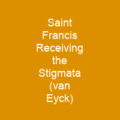The Virgin and Child with Canon van der Paele: A Masterpiece Unveiled
Imagine stepping back in time to 1434-1436, when Jan van Eyck painted a masterpiece that would become one of the most celebrated works of art. The Virgin and Child with Canon van der Paele is not just a painting; it’s a window into the religious and artistic world of 15th-century Flanders.
The Story Behind the Painting
Who commissioned this incredible work? Joris van der Paele, a wealthy canon, had his portrait included in the painting as an offering to the Virgin Mary. This was no ordinary commission; it was a personal request for protection and salvation after he fell ill.
The Artistic Genius of Jan van Eyck
Jan van Eyck’s Virgin and Child with Canon van der Paele is a testament to his unparalleled skill. The painting showcases the intricate details, rich iconography, and innovative use of illusionism that made him one of the most influential artists of his time.
The Iconography and Details
What makes this painting so special? It’s not just a portrait; it’s a narrative filled with symbolism. The Virgin Mary sits on an elevated throne, surrounded by saints like St. Donatian and St. George, each holding objects that tell their stories.

St. Donatian, dressed in a cope and mitre, holds a jewelled cross and candle wheel, while St. George stands confidently in his armour, raising his helmet to introduce the donor. The Virgin and Child panel is one of the earliest known northern European sacra conversazione paintings, setting a new standard for religious art.
The Journey of the Painting
How did this painting travel through time? After being installed in the church it was painted for, it faced numerous challenges. During the French Revolution, it was moved to a private house for safety. By 1600, it had been given a new setting and became part of the main altarpiece.
The painting’s journey continued when it was acquired by the Musée du Louvre in 1794 during the plundering of aristocrats’ estates. Its influence can be seen in numerous surviving copies from the 15th and 16th centuries, making it a cornerstone of art history.
Preservation and Restoration
How has this painting been cared for over the years? The Virgin and Child with Canon van der Paele has undergone several restorations. Jef Van der Veken worked on it in 1933-34, while Edmond Florens restored it in 1977. Despite these interventions, the panel remains in good condition, retaining its original frame and showing minimal damage.
Conclusion
The Virgin and Child with Canon van der Paele is more than just a painting; it’s a journey through time, a testament to the genius of Jan van Eyck, and a window into 15th-century religious devotion. Its intricate details, rich iconography, and innovative techniques continue to captivate art lovers today.
You want to know more about Virgin and Child with Canon van der Paele?
This page is based on the article Virgin and Child with Canon van der Paele published in Wikipedia (retrieved on November 29, 2024) and was automatically summarized using artificial intelligence.







